Gardens are more than just a random collection of plants; rather, they are carefully crafted spaces that often include a variety of structures to enhance their beauty, functionality, and organization.
From simple trellises to elaborate pergolas, garden structures serve multiple purposes, including providing support for plants, defining spaces, and adding design interest.
In this comprehensive guide, we will dig into garden structures, exploring their types, examples, and differences.
| Difference between garden structures | Pergola |
|---|---|
| Patio Cover | A pergola is an outdoor structure consisting of vertical posts and overhead crossbeams, forming an open framework that creates a charming interplay of light and shadow. On the other hand, patio covers present a contrasting option with their sturdy and enclosed structure, offering complete protection from the elements for your cherished patio. |
| Gazebo | A pergola has an open, slatted roof that allows dappled light through while a gazebo has a solid, enclosed roof that provides full shade coverage. |
| Ramada | A pergola is an open-air structure with a roof made of crossbeams, allowing partial sunlight and air to pass through. A ramada, on the other hand, is rectangular or square in shape and has a solid closed roof on top, providing complete shade and protection from dust, wind, and rain. |
| Pool House | A pergola is an open-sided structure with an open-rafter roof that offers partial shade, usually on a deck or patio. A greenhouse is a structure that creates its microclimate inside its walls, which is good for those who want to grow exotic plants or have homegrown food year-round. |
| Arbor | An arbor is generally smaller, serving as an ornamental archway covered in vines or climbing plants. It often acts as a welcoming entrance to a garden or an intimate, shaded spot for a bench. A pergola is a larger, more versatile outdoor structure, usually featuring a flat, open lattice roof supported by pillars. |
| Trellis | A trellis is a latticework used for climbing plants. A pergola is an open-sided structure with an open-rafter roof that offers partial shade, usually on a deck or patio. |
| Greenhouse | A pergola is an open-sided structure with an open-rafter roof that offers partial shade, usually on a deck or patio. A greenhouse is a structure that creates its own microclimate inside its walls, which is good for those who want to grow exotic plants or have homegrown food year-round. |
Pergola Garden Structures
Pergolas are outside structures consisting of vertical posts supporting cross beams and an open rooftop. They include an open lattice design, providing partial shade and a sense of enclosure while allowing sunlight and air to filter through.

Pergolas are also known as Arbors or Open-air Pavilions, depending on their design and size.
Types and Examples
Modern Metal Pergola
Modern Metal Pergolas are made up of materials such as Aluminium or Steel, having a minimalist design with sleek lines. These are generally suitable for urban settings or contemporary gardens.
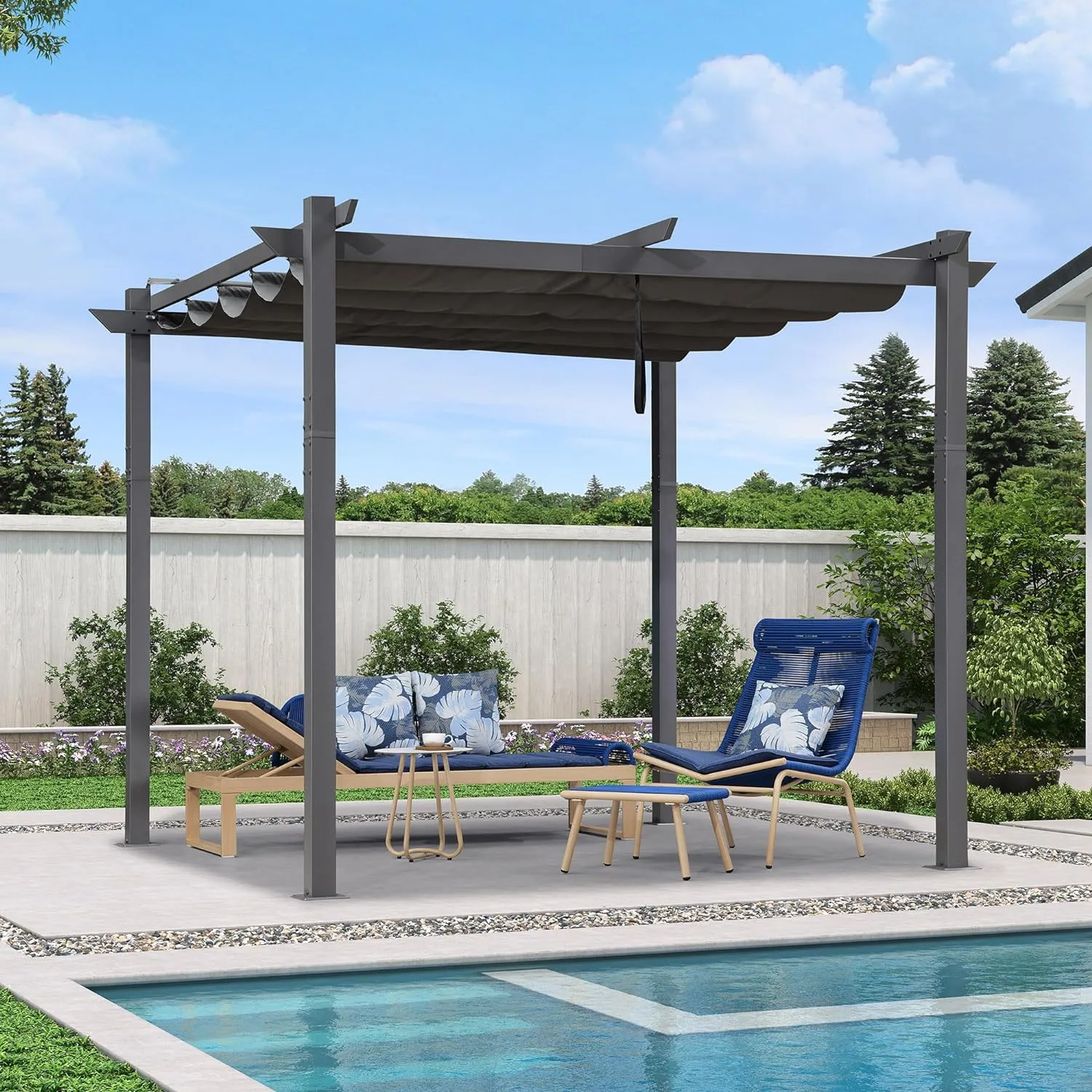
Traditional Wooden Pergolas
Traditional Wooden Pergolas are generally made up of Redwood or Cedar. These are known for featuring cross beams and classic lattice sides. These are often suitable for various garden styles, from rustic to formal.

Suitability
People generally prefer Pergolas for outdoor spaces when they have architectural interest, shade, and a sense of enclosure. They are commonly found in parks, residential areas, and outdoor dining areas.
Materials
Wood: Redwood, Cedar of Pressure-treated Lumber.
Metal: Aluminium, Steel, or Wrought Iron.
Vinyl: Low maintenance option resistant to rot and insects.
Design Ideas
Try to incorporate climbing plants like Wisteria or Grape Vines to create a natural canopy.

Add outdoor curtains or retractable shades for additional privacy and sun protection.

Install lighting fixtures or string lights for ambiance.

Prices
The cost of a pergola varies depending on factors like size, materials, and design complexity. A basic wooden pergola kit can start around $500, while custom-built or larger metal pergolas might go from $1,000 to $5,000 or more.
Patio Cover
A patio cover is a structure designed to provide shade and protection for outdoor patio spaces. It generally consists of a rooftop supported by posts or columns, extending from the exterior wall of a building or freestanding within a patio area.

Patio covers are often known as Awnings or Shade Structures depending on their design and functions.
Types and Examples
Solid Patio Cover
It features a strong rooftop constructed from materials like wood, metal, or shingles, offering complete shade and protection from the elements.

Lattice Patio over
Consists of a roof made of open grids or lattices, allowing some shade and ventilation while still allowing some sunlight to pass through.

Suitability
Patio covers are most suitable for outdoor spaces like patios, decks, or poolside areas where shade and shelter are desired. They make outdoor living more comfortable and enjoyable by shielding you from direct sunlight, rain, and other weather conditions.
Materials
Wood: Redwood, Cedar, or pressure-treated lumber for a natural look.
Metal: Aluminium, Steel, or Wrought iron for modern aesthetics and durability.
Fabric: Waterproof or UV-resistant fabrics like polyester or acrylic for retractable awnings.
Design Ideas
Integrate ceiling fans or misting systems for added solace in hot climates.

Incorporate lighting fixtures or string lights for ambiance during evening gatherings.

Add decorative elements like curtains, plants, or outdoor furniture to enhance the overall aesthetic.

Prices
The cost of a patio cover differs depending on factors like size, materials, and design complexity. Basic solid wood or metal patio covers can start around $1,000 to $3,000, while more elaborate designs or retractable awnings might go from $3,000 to $10,000 or more.
Gazebo
A gazebo is a freestanding outdoor structure generally found in gardens, parks, or lawn spaces. It has a roof that is supported by pillars or columns and often has open sides or lattice walls. This makes it a safe place to sit or a point of interest in the landscape.

Gazebos are often known as Pavilions or Pergolas, depending on their size, design and functions.
Types and Examples
Traditional Wooden Gazebo
Traditional Wooden Gazebos are made up of woods such as Cedar or Redwood, having a classic octagonal shape and lattice sides. These are generally preferred to give a rustic touch to garden settings.

Metal Gazebos
Metal Gazebos are often made up of materials such as wrought iron or Aluminium. These are generally suitable for urban gardens and contemporary outdoors.

Suitability
Gazebos are generally suitable for outdoor spaces where sheltered seating, entertaining, or relaxation areas are desired. They provide shade, protection from the elements, and a focal point for get-togethers, making them famous additions to residential gardens, parks, and public spaces.
Materials
Wood: Cedar, redwood, or pressure-treated lumber for a natural look and durability.
Metal: Aluminum, steel, or wrought iron for strength and modern aesthetics.
Vinyl: Low-maintenance option resistant to rot, insects, and weather damage.
Design Ideas
Decorate with outdoor curtains, drapes, or screens for privacy and shade.

Incorporate seating like benches, chairs, or swings for comfortable lounging.

Add lighting fixtures, chandeliers, or string lights for ambiance during evening gatherings.

Prices
The cost of a gazebo differs depending on factors like size, materials, and design complexity. Basic wooden gazebo kits can start around $1,000 to $3,000, while custom-built or larger metal gazebos might go from $3,000 to $10,000 or more.
Ramada
A Ramada is a kind of outdoor structure like a gazebo or pergola, yet with a distinct Southwestern or Mediterranean architectural style. It normally includes a solid rooftop supported by sturdy posts or columns and may have open or partially closed sides. Ramadas are often used for outdoor dining, entertaining, or relaxation and are popular in regions with hot climates.

Ramadas are often known as Shade Structures, Outdoor Pavilions, or Open-air shelters, depending on their design and function.
Types and Examples
Traditional Ramada
Traditional Ramadas are built from the material like wood and adobe, having a flat or slightly sloped roof and open sides. These Ramadas are commonly found in Southwestern-style gardens or desert landscapes.

Modern Ramada
Modern Ramadas are made up of materials like concrete, glass or metals with sleek lines and minimalist design elements. These Ramadas are suitable for contemporary outdoor spaces or urban environments.

Suitability
Ramadas are generally suitable for open air spaces where shade, shelter, and architectural interest are desired. They provide relief from intense sunlight and heat, making them ideal for residential gardens, parks, poolside areas, and outdoor dining or entertaining spaces.
Materials
Wood: Redwood, Cedar or treated lumber for a natural look and durability.
Metal: Aluminium, Steel, Wrought Iron for strength and modern aesthetics.
Adobe: Traditional material in Southwestern architecture, providing thermal mass and insulation.
Fabric: Waterproof or UV-resistant fabrics like polyester or acrylic for retractable awnings or shade sails.
Design Ideas
Incorporate decorative elements like latillas, vigas, or corbels for a Southwestern or Mediterranean aesthetic.
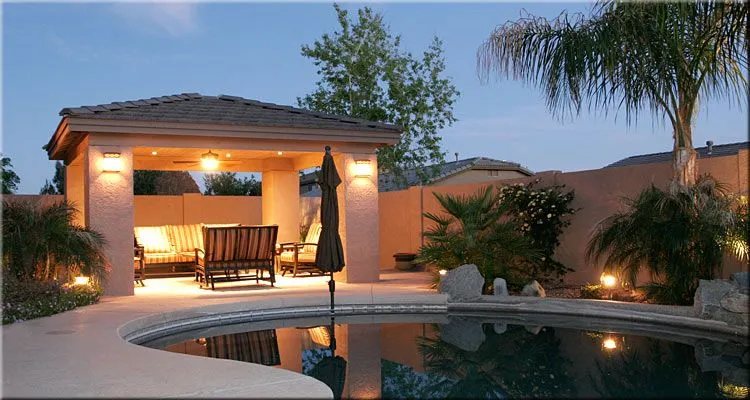
Add outdoor furniture, lighting fixtures, or ceiling fans for comfort and ambiance.

Include built-in features like fireplaces, kitchens, or seating areas for functionality and style.

Prices
The cost of a Ramada varies depending on factors such as size, materials, and design complexity. Basic wooden Ramada kits can start around $1,000 to $3,000, while custom-built or larger metal or adobe Ramadas might go from $5,000 to $20,000 or more.
Cabana / Pool House
A pool house is a standalone structure adjacent to a swimming pool, designed to provide amenities and convenience for pool users. It commonly includes features such as changing rooms, showers, bathrooms, storage for pool equipment, and sometimes a kitchenette or lounge area.
Pool Houses are often known as Pool Cabanas, pool pavilions, and poolside retreats.
Types and Examples
Traditional Pool House
It is a small cottage or guest house with a gable roof, windows, and doors. It includes multiple rooms for changing, showering, and relaxing.

Modern Pool House
It includes features such as sleek lines, minimalist design, large windows or glass doors. It often includes contemporary materials like metal, glass, or concrete for a sleek, upscale look.

Suitability
Pool houses are generally suitable for private properties with swimming pools, providing convenience, privacy, and additional space for entertaining or relaxing. They are popular in warm climates where outdoor living is common but can be enjoyed in any location with a pool.
Materials
Wood: Cedar, redwood, or treated lumber for a traditional or rustic look.
Metal: Aluminum, steel, or wrought iron for modern aesthetics and durability.
Concrete: Versatile material for floors, walls, and countertops, offering strength and ease of maintenance.
Glass: Used for windows, doors, and walls to maximize natural light and views of the pool area.
Design Ideas
Include a covered patio or pergola adjacent to the pool house for outdoor dining or lounging.

Install a fireplace or outdoor kitchen for year-round enjoyment and entertaining.

Incorporate sliding glass doors or folding walls to blur the lines between indoor and outdoor living spaces.

Prices
The expense of a pool house varies widely depending on factors like size, materials, amenities, and level of customization. Basic prefab pool house kits can start around $5,000 to $20,000, while custom-built or luxury pool houses might go from $50,000 to $200,000 or more.
Arbor
An arbor is a simple outdoor structure consisting of vertical posts or columns supporting an open framework, often in an arch shape. Arbors are typically used as decorative elements in gardens, providing support for climbing plants like roses, vines, or jasmine. An Arbor can also be used as an entrance, focal point, or transition point.
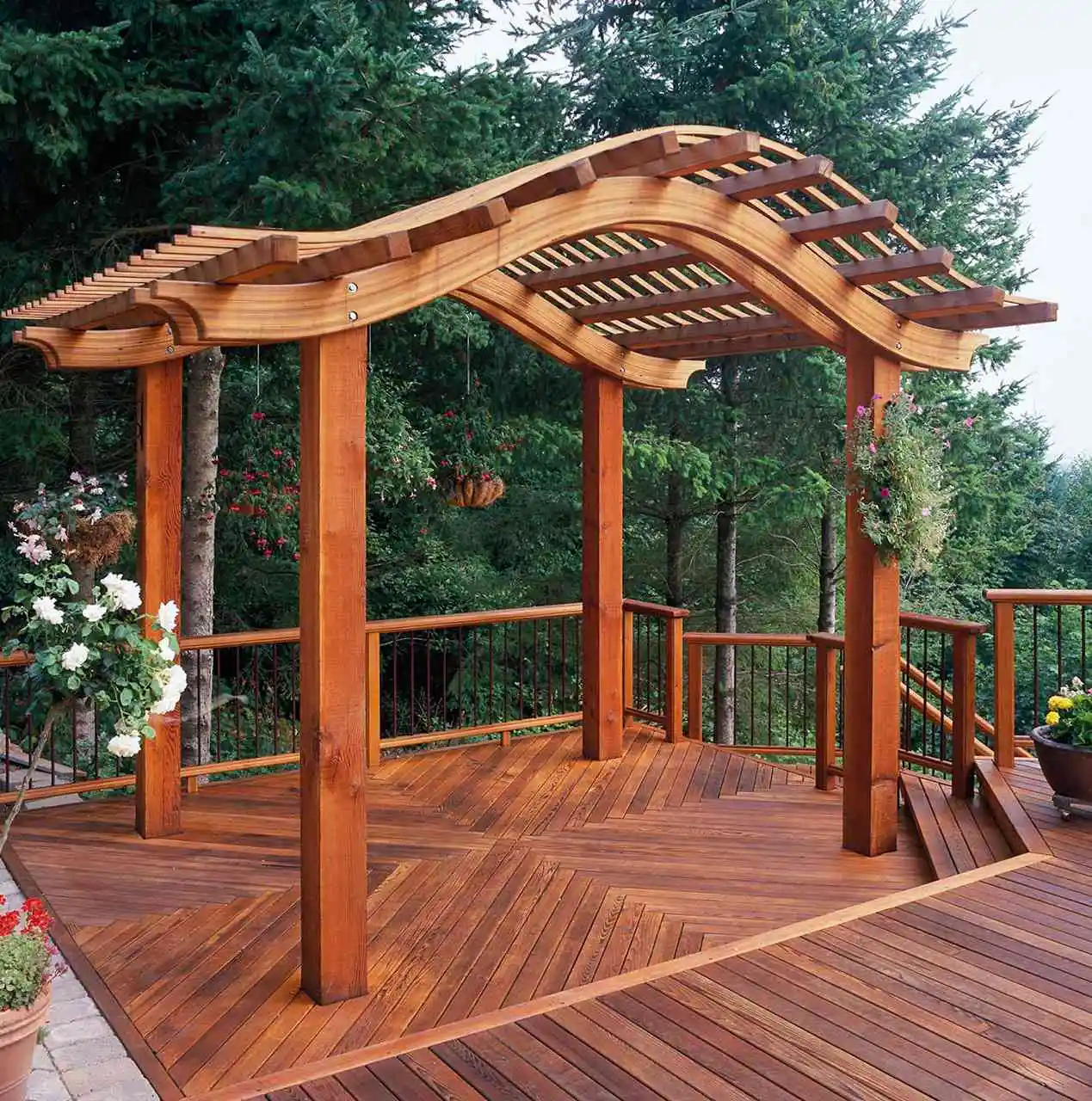
Arbors are often known as Garden arches, pergolas, or trellises depending on their design and function.
Types and Examples
Classic Wooden Arbor
Built from materials like cedar or redwood, including a traditional arch shape with grid or slatted sides. Commonly adorned with climbing roses or flowering vines.
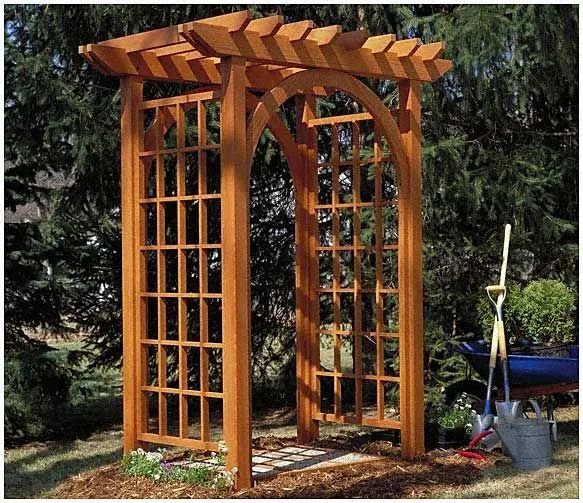
Metal Arbor
Made of materials such as wrought iron or aluminum, with intricate designs or scrollwork. Suitable for adding a touch of elegance to formal gardens or contemporary landscapes.

Suitability
Arbors are most suitable for residential gardens, parks, or outdoor spaces where vertical interest, shade, or architectural detail is desired. They can be used to define entrances, pathways, or garden borders, creating a sense of enclosure and intimacy within the landscape.
Materials
Wood: Cedar, redwood, or pressure-treated lumber for a natural, rustic look.
Metal: Wrought iron, aluminum, or steel for durability and decorative appeal.
Vinyl: Low-maintenance option resistant to rot, insects, and weather damage.
Design Ideas
Plant climbing roses, jasmine, or clematis to grow over the arbor, creating a fragrant and colorful canopy.
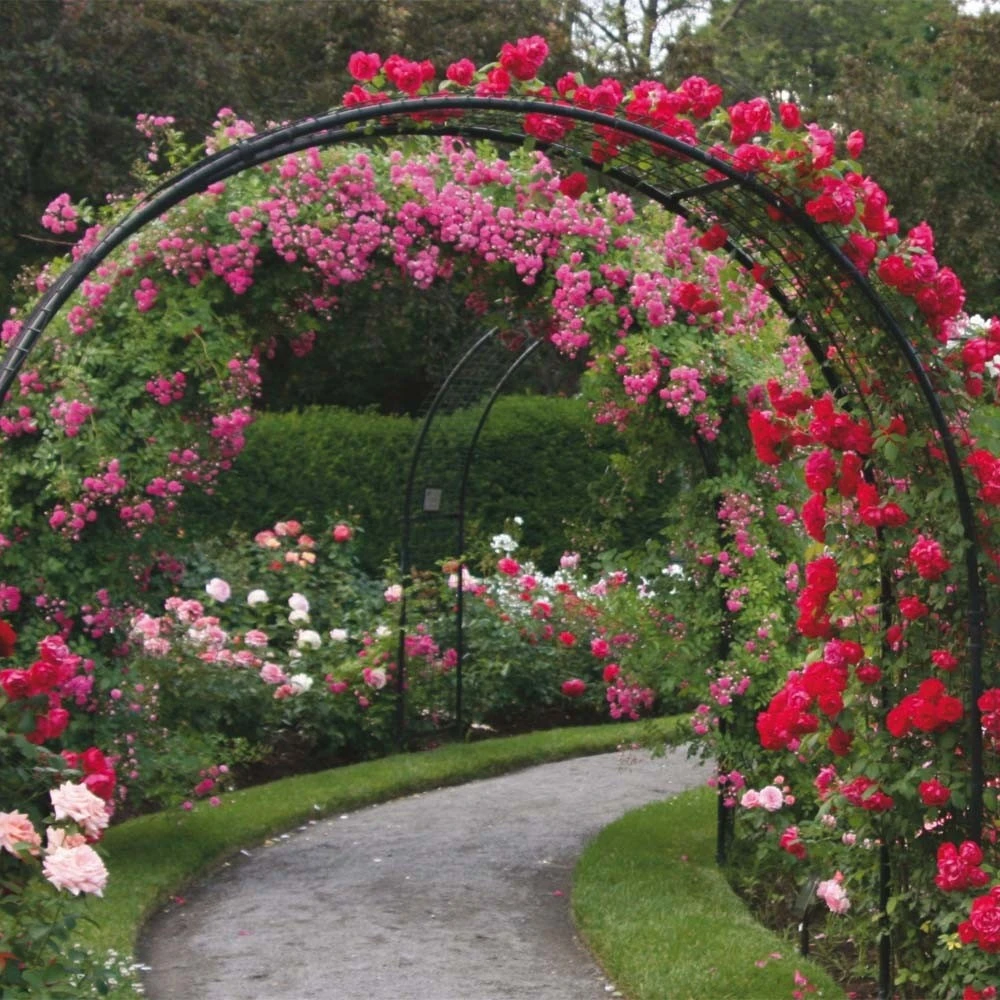
Add a bench or seating area beneath the arbor for a cozy spot to relax or enjoy the garden views.

Incorporate lighting fixtures or string lights for ambiance during evening gatherings.

Prices
The cost of an arbor fluctuates depending on factors like size, materials, and design complexity. Basic wooden arbor kits can start around $100 to $500, while custom-built or larger metal arbors might go from $500 to $2,000 or more.
Trellis
A Trellis is a vertical structure consisting of an open framework of intersecting pieces, used to support climbing plants and vines in gardens or outdoor spaces. Trellises offer both practical support for plants and act as embellishing elements, adding vertical interest and visual appeal to the landscape.

Trellises are often known as Espaliers, Climbing frames or lattice screens depending on their design and function.
Types and Examples
Wooden Trellis
Wooden Trellis (also used in vertical gardening) is made up of materials such as redwood or cedar and features a grid pattern. These are commonly used for supporting climbing vegetables, flowers, or vines in vegetable gardens or song fences.

Metal Trellis
Metal Trellis is made of materials such as wrought iron, aluminum, or steel, with intricate designs or scrollwork. Suitable for adding a touch of elegance to formal gardens or contemporary landscapes.

Suitability
Trellises are best suited for vertical gardening, screening, or space optimization in outdoor spaces, parks, or residential gardens. They can be used to cover unsightly areas like fences and walls, create privacy screens, and define the boundaries of gardens.
Materials
Wood: Cedar, redwood, or pressure-treated lumber for a natural, rustic look.
Metal: Wrought iron, aluminum, or steel for durability and decorative appeal.
Vinyl: Low-maintenance option resistant to rot, insects, and weather damage.
Design Ideas
Train climbing roses, cucumbers, or grapevines to grow over the trellis, creating a lush and vibrant vertical garden.

Paint or stain the trellis to match existing outdoor decor or add a pop of color to the garden.

Combine multiple trellises to create a living privacy screen or divide outdoor spaces into separate garden rooms.

Prices
The cost of a trellis varies depending on factors like size, materials, and design complexity. Custom-built or larger metal trellises can cost anywhere from $100 to $500, while basic wooden trellises start around $20 to $100.
Greenhouse
A greenhouse is designed for cultivating plants in a controlled environment. It protects plants from bad weather and makes the best conditions for growing a variety of crops.
Greenhouses range in size from small backyard structures to large commercial facilities and can be used for growing flowers, vegetables, herbs, or ornamental plants all year.
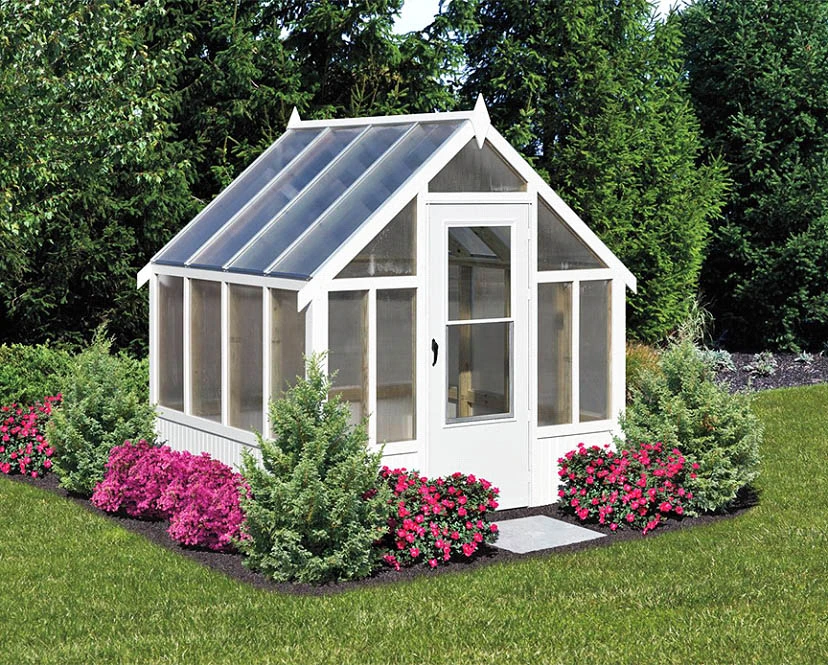
Greenhouses are often known as Conservatories or hothouses depending on their design and function.
Types and Examples
Traditional Glass Greenhouse
Traditional Glass Greenhouses are constructed with glass panels or sheets, allowing maximum sunlight penetration and heat retention. Often used for large-scale gardening or commercial production.

Polycarbonate Greenhouse
Polycarbonate Greenhouses are made of polycarbonate panels or sheets, offering durability, UV protection, and insulation. These are suitable for backyard gardeners or hobbyists.

Lean-to Greenhouse
Lean-to Greenhouses are attached to a structure such as a house or garage, maximizing space and utilizing the heat and energy in the building. Ideal for small yards or urban gardens.

Suitability
Gardeners, farmers, and other enthusiasts who want to extend the growing season, propagate plants, or cultivate specialty crops are best suited for greenhouse use. They work best in areas with short growing seasons, high temperatures, or limited outdoor space.
Materials
Glass: Provides maximum light transmission and heat retention but may be expensive and prone to breakage.
Polycarbonate: Offers durability, insulation, and UV protection at a lower cost than glass.
Aluminum: Lightweight, corrosion-resistant material used for framing and structure.
Design Ideas
Incorporate shelving, benches, or hanging baskets for efficient use of space and organization.

Install ventilation systems, fans, or automatic vents to regulate temperature and humidity.

Add heating, cooling, or misting systems for climate control and plant health.

Prices
The cost of a greenhouse varies depending on factors like size, materials, and design complexity. Basic backyard greenhouse kits can begin around $200 to $1,000, while larger or custom-built structures might go from $1,000 to $10,000 or more.
Summerhouses
A summerhouse is a small, detached structure that can be found in a garden or backyard during the warmer months. Its purpose is to provide a safe and peaceful area for relaxation, recreation, or outdoor dining.
Summerhouses can be rustic or modern in style and feature a variety of large windows that let in a lot of natural light and provide views of the surrounding landscape.

Summerhouses are often known as Garden rooms, outdoor pavilions or backyard cottages.
Types and Examples
Traditional Wooden Summerhouse
Traditional Wooden Summerhouses are made from materials like cedar, redwood, or treated lumber, with a pitched rooftop and large windows. Often adorned with decorative trim or accents.

Contemporary Glass Summerhouse
Contemporary Glass Summerhouses feature modern design elements like flat rooftops, clean lines, and floor-to-ceiling windows or glass walls. It provides unobstructed views of the garden and ample natural light.

Suitability
Summerhouses are most suitable for residential properties with spacious gardens or backyards, providing a private retreat for relaxation, reading, or entertaining guests. They can be used as a home office, studio, or guest room, making them ideal for outdoor living during the warmer months.
Materials
Wood: Cedar, redwood, or treated lumber for a natural, rustic look and durability.
Glass: Used for windows, doors, and walls to maximize natural light and views of the garden.
Metal: Aluminum or steel for framing and structure, offering strength and modern aesthetics.
Design Ideas
Furnish with comfortable seating, cushions, and throws for a cozy and inviting atmosphere.

Add a small table or dining set for outdoor meals, tea parties, or gatherings with friends.

Incorporate decorative elements like potted plants, hanging baskets, or outdoor rugs to personalize the space.
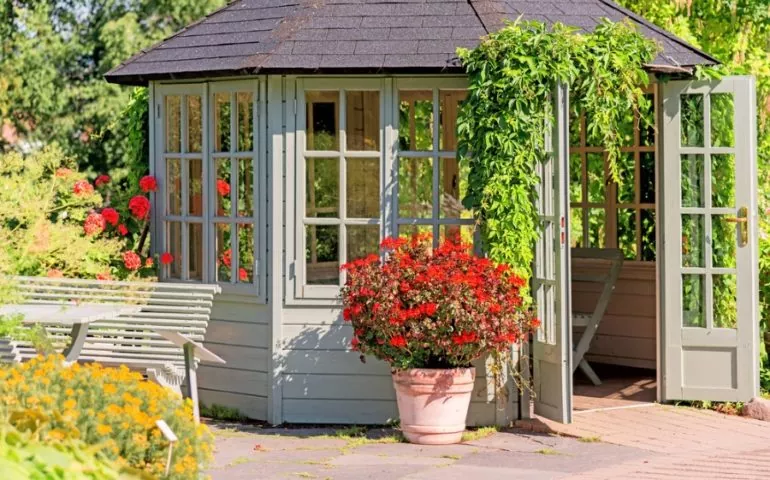
Prices
The cost of a summerhouse varies depending on factors such as size, materials, and design complexity. Basic wooden summerhouse kits can start around $1,000 to $5,000, while custom-built or larger glass summerhouses might go from $5,000 to $20,000 or more.
Folly
A folly is a structure or ornament in gardens, parks, or other landscapes that is mostly made for aesthetic pleasure rather than for any practical purpose and is often whimsical.
Follies can take various forms, from architectural ruins and faux temples to miniature castles and whimsical sculptures. They add visual interest, intrigue, and a sense of playfulness to outdoor spaces.

Follies are often known as Garden ornaments, architectural whimsies, or landscape features.
Types and Examples
Ruin Folly
It mimics the appearance of ancient architectural ruins, for example, crumbling columns, arches, or walls. Often made of stone or weathered materials to convey authenticity and age.

Temple Folly
Resembles classical Greek or Roman temples, featuring columns, pediments, and decorative elements. Provides a focal point or gathering place within a garden or park setting.

Grotto Folly
Recreates the look of natural caves or grottos, with rockwork, water features, and artificial stalactites. Offers a tranquil retreat or contemplative space for meditation.

Sculptural Folly
Takes the form of whimsical sculptures or art installations, such as oversized animals, abstract shapes, or fantastical creatures. Adds an element of surprise and wonder to the landscape.

Suitability
Follies are most suitable for large-scale gardens, public parks, or expansive landscapes where there is ample space for creative expression and exploration.
They can attract visitors to wander, discover, and interact with their surroundings by acting as focal points, landmarks, or destinations within the landscape.
Materials
Stone: Natural stone or faux stone materials like concrete or cast stone for durability and authenticity.
Wood: Timber or treated lumber for rustic or whimsical designs, often painted or stained for visual impact.
Metal: Wrought iron, steel, or aluminum for decorative elements or structural support.
Synthetic: Resin, fiberglass, or composite materials for lightweight and weather-resistant sculptures or ornaments.
Design Ideas
Incorporate follies into garden layouts, creating focal points or sightlines to draw the eye and encourage exploration.
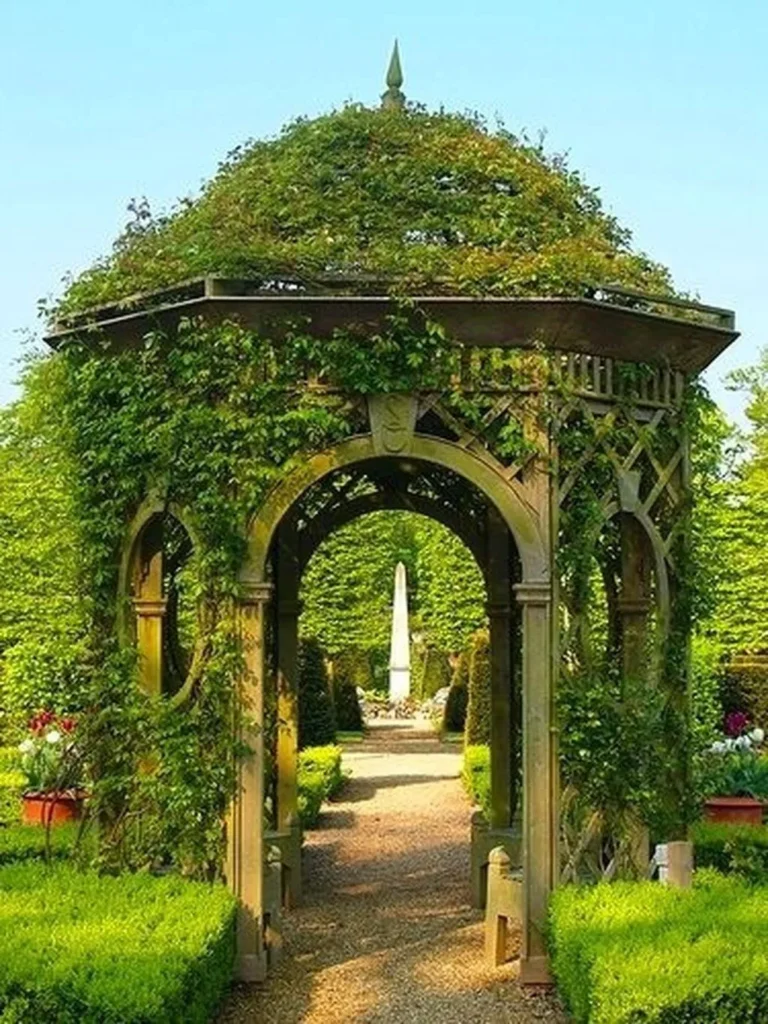
Combine multiple follies to create themed areas or storybook landscapes, such as a fairy tale garden or enchanted forest.

Use lighting, landscaping, and plantings to enhance the ambiance and atmosphere around follies, creating magical and immersive experiences.

Prices
The cost of a folly varies depending on factors like size, materials, design complexity, and craftsmanship. Basic garden ornaments or sculptures can begin around $50 to $500, while larger or custom-built follies might go from $1,000 to $10,000 or more.
Garden Arches
A garden arch is a decorative structure that is typically used to frame a path or entrance in a garden. It is made up of an arched structure that is supported by posts or columns that are vertical. This gives climbing plants like roses, vines, or jasmine support while also making it a pretty focal point.
Garden Arches are often known as arbors, trellises, or pergolas, depending on their design and function.
Types and Examples
Classic Wooden Garden Arch
Constructed from materials like cedar or redwood, featuring a traditional arched shape with grid or slatted sides. Usually adorned with flowering vines or climbing roses.
Metal Garden Arch
Made of materials such as wrought iron, aluminum, or steel, with intricate designs or scrollwork. Suitable for adding a touch of elegance to formal gardens or contemporary landscapes.
Suitability
Garden arches are most suitable for residential gardens, parks, or outdoor spaces where vertical interest, design, or definition is desired. They can be used to mark entryways, pathways, or changes within the garden, creating a sense of enclosure and guiding visitors through the landscape.
Materials
Wood: Cedar, redwood, or pressure-treated lumber for a natural, rustic look.
Metal: Wrought iron, aluminum, or steel for durability and decorative appeal.
Vinyl: Low-maintenance option resistant to rot, insects, and weather damage.
Design Ideas
Train climbing roses, clematis, or honeysuckles to grow over the arch, creating a fragrant and colorful canopy.
Add a bench or seating area beneath the arch for a cozy spot to relax or enjoy the garden views.
Incorporate lighting fixtures or string lights for ambiance during evening gatherings.
Prices
The cost of a garden arch varies depending on factors like size, materials, and design complexity. Basic wooden arch kits can start around $50 to $200, while custom-built or larger metal arches might go from $200 to $500 or more.
Sheds
A shed is a small, enclosed structure typically found in residential properties, used for storage, workshops, or hobby spaces. Sheds come in various sizes and designs, ranging from basic utility buildings to more elaborate structures with windows, doors and customizable interiors.
Sheds are often known as storage buildings, outbuildings or garden cottages, depending on their design and function.
Types and Examples
Utility Shed
Utility Shed: A simple, functional structure with a single door and minimal windows, used for storing tools, equipment, or garden supplies.
Garden Shed
Similar to a utility shed but designed specifically for gardening tools, potting supplies, and outdoor equipment.
Workshop Shed
Equipped with workbenches, shelves, and storage units, providing space for woodworking, DIY projects, or hobbies.
Studio Shed
Designed as a creative workspace or retreat, with features like windows, skylights, and insulation for comfort and natural light.
Suitability
Sheds are most suitable for residential properties where additional storage space, workspace, or functional areas are needed. They can be placed in backyard gardens, side yards, or detached garages, providing convenient access to tools, equipment, or hobby supplies.
Materials
Wood: Cedar, redwood, or treated lumber for a natural, rustic look and durability.
Metal: Galvanized steel or aluminum for strength, security, and low maintenance.
Vinyl: Weather-resistant material resistant to rot, insects, and fading, requiring minimal upkeep.
Design Ideas
Customize the interior with shelves, cabinets, pegboards, and workbenches for efficient organization and functionality.
Add windows, skylights, or dormers for natural light and ventilation.
Incorporate decorative elements like flower boxes, shutters, or trim to enhance the shed’s appearance.
Prices
The size, materials, complexity of the design, and optional features all influence the price of a shed. Basic prefabricated shed kits can start around $200 to $1,000, while custom-built or larger sheds might go from $1,000 to $10,000 or more.
Pavilion
A Pavilion is a freestanding outdoor structure with a rooftop and open sides, designed for shelter, relaxation, or entertainment. Pavilions vary in size and design, ranging from small backyard structures to large public gathering spaces, and they can serve multiple purposes, including hosting events, providing shade, or simply creating a focal point in the landscape.
Pavilions are often known as outdoor shelters, gazebos, or pergolas, depending on their design and function.
Types and Examples
Traditional Wooden Pavilion
Constructed from materials like cedar or redwood, featuring a gabled roof, sturdy posts, and open sides. Commonly used for picnics, outdoor dining, or social gatherings in parks or gardens.
Modern Metal Pavilion
Made of materials such as aluminum or steel, with sleek lines, minimalist design, and large windows or glass walls. Suitable for contemporary outdoor spaces or urban environments.
Suitability
Pavilions are most suitable for outdoor spaces where sheltered seating, entertaining, or relaxation areas are desired. They provide shade, protection from the elements, and a focal point for gatherings, making them popular additions to residential gardens, parks, and public spaces.
Materials
Wood: Cedar, redwood, or pressure-treated lumber for a natural, rustic look and durability.
Metal: Aluminum, steel, or wrought iron for strength, modern aesthetics, and longevity.
Fabric: Waterproof or UV-resistant fabrics like polyester or acrylic for retractable awnings or shade sails.
Design Ideas
Incorporate outdoor curtains, drapes, or screens for privacy and shade.
Add outdoor furniture, lighting fixtures, or ceiling fans for comfort and ambiance.
Include built-in features like fireplaces, kitchens, or seating areas for functionality and style.
Prices
The cost of a pavilion varies depending on factors like size, materials, design complexity, and additional features. Basic wooden pavilion kits can start around $1,000 to $5,000, while custom-built or larger metal pavilions might go from $5,000 to $20,000 or more.
Wrapping up…
Garden structures offer a bunch of choices to enhance outdoor spaces, from providing shade and shelter to adding architectural interest and defining areas.
Whether you choose a classic pergola, a flexible patio cover, or a whimsical folly, there’s a design to suit every style and need.
With careful planning and design, these structures can transform gardens into inviting and functional retreats for relaxation, entertainment, and enjoyment of nature.
Image credits: all images are non-copyrighted and available on the internet for free use. Credits to the respective authors. Please let us know if you want to claim an image used on the site.








